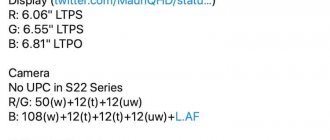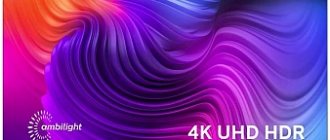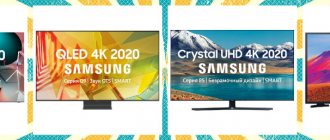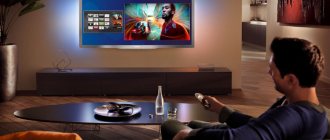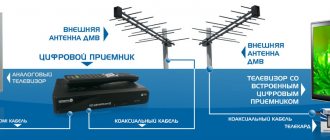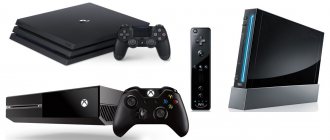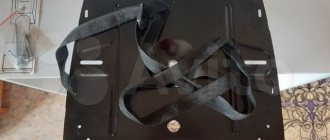TV manufacturers are trying to keep up with the times and are trying in every possible way to ensure that their devices are not inferior to computer technologies, and, if possible, replace them. This is why the Smart TV function was invented, which is now found on almost all more or less decent models. But making the right choice in 2021 is very difficult, because... the abundance of models simply confuses and confuses buyers. That's why we're bringing you today's selection of the 10 best 40-inch TVs you can find on sale.
Why is it worth buying a 40 diagonal TV?
Initially, we will explain why TVs with this diagonal are in great demand. The fact is that the size of this TV will allow you to install it in almost any room, except, perhaps, the bathroom. As for the living room, bedroom or kitchen, a 40-inch TV will find application everywhere.
All thanks to the fact that the diagonal of the TV will allow you to maneuver in terms of its installation. In order not to strain your eyes, you will need to install the TV in such a way that it is 2 - 2.5 m from your eyes, so that you do not damage your eyesight and, at the same time, can fully enjoy the content you are watching.
The most important thing is the presence of the Smart TV function, which will allow you not only to watch regular TV channels, but also to do your business on the Internet. This is not only online cinema and YouTube, but even search engines and visiting various sites. And below you will get acquainted with the highest quality and most functional TVs in this category.
Selection options
Despite the simplicity of the function in the form of image output, TVs have many non-obvious characteristics. Let's analyze the main parameters and determine successful models for purchase.
Matrix type
A matrix is a set of dots on a display. Each image unit is represented by a pixel, which lights up according to the output picture. There are more than a million of them collected on the matrix. This is how the user interacts with the device. The matrix uses the pixel and sets it the required color tone; in the team, all the pixels already show some kind of scenes. The quality of viewing depends directly on it.
Liquid crystal (LCD) technology is the most popular type among the options on the market.
LCDs occupy a large space among popular models, which vary greatly. Here is a list of popular LCD matrices:
- TFT TN;
- TFT IPS;
- pls;
- TFT VA;
There are other matrices that are less common. Such matrices are installed in more premium solutions, so they are more difficult to come across. These types stand out:
- OLED;
- QLED;
Inexpensive
The most affordable version of the LCD display is the TFT TN matrix. On such a screen it is not possible to fully show black color; it is often shifted to gray. Yes, and other colors are transmitted with slight highlights.
TFT TN has poor visibility; to display colors correctly you need to be at right angles in front of the screen. With small deviations, the color is distorted up to the inversion effect.
Low price is the main advantage of TFT TN. For better color display, deep blacks and small viewing angles, install the TFT IPS version. This is a more expensive matrix, but it provides a high level of video. There is also a PLS matrix, this is Samsung’s own development based on IPS. Samsung is actively promoting its technology as an ideal alternative, but manufacturability is not enough for a full replacement.
There is also a TFT VA matrix, this is something between TN and IPS screens.
VA features detailed blacks, increased contrast and better response times.
At the same time, it has poor viewing angles compared to its competitors. It gained popularity due to its affordable price, located between IPS and TN. Most often, such a matrix can be found in Samsung.
Premium
LCD matrices are in wide demand, but in addition to them there are OLED and QLED. These are the best matrices.
They provide perfect blacks, high contrast, brightness and suitable color rendition.
But their main disadvantage is the price. Such gadgets cost about 100,000 rubles, so they are not common. QLED differs from OLED for the better. At the moment, the top-end solution will be QLED (or Nano Cell).
The only drawback that worries many buyers is pixel burnout and short service life.
Indeed, OLED and QLED live less than their competitors, but even this is enough for correct operation for at least 10 years.
On some TVs you will notice the designation LED (light emitting diode), namely Edge LED and Direct LED. In fact, LED is a designation for the display backlight, not its matrix. Therefore, TVs can be with any type of liquid crystal matrix (TN, IPS, PLS or VA) and LED technology at the same time. The Edge version has LEDs only at the edges of the matrix and provides uneven illumination, while Direct, on the contrary, distributes brightness evenly. Edge LED is needed for thin cases because it can provide sufficient compactness.
Matrix resolution
Each matrix has its own resolution. This is a designation for the total number of pixels. The more pixels, the more beautiful the image will be. It’s simple here, the more the better. But display resolution affects its cost, so many users buy TVs with a lower resolution to save money.
Resolution is displayed in the number of pixels in width and height; models with larger numbers give a more detailed picture.
Here are the modern matrix resolution types used in most screens:
- HD or 720p (1280×720);
- FullHD or 1080p (1920×1080);
- 4K (3840x2160).
The most popular resolution is Full HD, or 1920 by 1080 pixels. This resolution produces clear images and is not expensive.
TV channels often broadcast content in HD or FullHD, so there is no point in buying higher resolution for cable TV. Many modern films, shows and blogs are already shot in 4K. This is the resolution of the future, which little by little everyone is striving for. But at the moment there is not much sense in such a resolution. FullHD displays the image quite well, no pixels are visible on the screen.
Better versions will be needed sooner in the future, when all content will be created with 4K support. However, such content can be viewed on both HD and FullHD without any problems. If your budget allows, then it’s definitely worth going for 4K.
Availability of Smart TV
Another important point will be the presence of the Smart TV function. Smart is actually smart functions. Smart TV allows you to view content via Wi-Fi, USB, Bluetooth from built-in programs. The firmware is already installed on the TV and can work without problems.
You just need to connect your smart phone to the network and you can view both central channels and Youtube, a browser, and so on.
Without a Smart TV, it only works as a playback player. You will need to connect an external source to it. For example, an antenna, tuner, TV box or something else. It’s better, of course, to buy from Smart, but external sources are also quite good for saving money.
Many people prefer to save money and buy a device without Smart, and then connect a TVBox to get the necessary functions. TV Box provides the same functions as Smart, only it needs to be purchased separately and connected to the TV via a wire. Another reason to abandon Smart would be to use the TV only to watch cable channels. If a person does not need Internet on TV, then saving is appropriate. Also, it doesn’t make sense to take Smart for games via consoles, since many consoles are smart in themselves and can perform all Smart functions.
Smart TV is a set of programs inside a gadget. This solution has its own RAM and built-in memory, power and workmanship.
Cheaper options with Smart may experience lags in the system, long loading times and other problems. Therefore, it is better to buy Smart in expensive models so that it works properly. TVBox, in turn, work quickly, often faster than the built-in Smart. This is a big advantage of TV boxes; they are increasingly preferred to be used instead of Smart TV.
Smart TV comes in different subcategories. More precisely, the built-in firmware is different. Each manufacturer uses its own firmware. They differ in functionality, convenience and interface. Sometimes having Smart does not provide advantages due to terrible sales of products.
Kinds
Smart TVs vary in operating system. It is up to the buyer to choose his favorite system, because they are completely different and will suit different types of people. There are three main types of OC, namely:
- TizenOS;
- WebOS 2.0;
- Android TV.
Tizen is Samsung’s own development; all its TVs have this operating system in Smart.
It features a simple interface and a convenient remote control. It has everything you need, namely watching movies, YouTube, browser, music, etc.
WebOS uses LG. It is similar to the Samsung development, just as easy and understandable.
It has a more laconic design, different streaming services and a control method.
And the latest giant is Android TV. This is a full-fledged green robot. On such a TV you can install games and applications from Google Play (supported), launch the apk, and so on. This is a detailed and feature-rich shell, but it requires a lot of power.
In weak devices Smart often lags. And the interface is not the most convenient, you need to get used to it due to the large range of functions.
Yes, there are many more of them, but often they are not needed, but only load the system. Before purchasing, you should think about whether such abundance is needed for an indoor device. All TVBoxes have Android TV installed.
Sound
Matrix specialization is important, but sound also plays an important role in immersion. The speakers do not stand out with particular clarity and volume due to their size. Usually all TVs sound suitable, there is no fundamental difference.
It is recommended to take a stereo headset. This is when two speakers are installed in the case, working separately to create the effect of presence in the scene.
It is worth paying attention to the presence of a 3.5 mm mini-jack for connecting external audio devices such as speakers or headphones. This connector should be in a convenient location. Having the latest version of Bluetooth will help transmit better sound to wireless gadgets.
Design and dimensions
Design is a characteristic of taste, everyone takes what they like. But if there are a couple of fundamental differences, which inexperienced users often do not pay attention to. The first is the legs. There are several types of stands, from a thick single leg to two small ones on the edges.
Before purchasing, you need to make sure that the TV does not wobble and stands confidently. There is no specific standard indicating which legs are better, it depends on the performance in a particular model.
The second important design difference concerns the ports. You need to pay attention to the location of the ports and their sufficient number. They are installed in the back wall, on the sides, or in the bottom frame. Depending on the room, it is more convenient to place the ports on the left or right. Often TVs are not suitable because it is difficult to reach the USB behind the covering furniture. To save money, many manufacturers sacrifice the number of ports. You should make sure that there are the right number of connectors so that you can connect the necessary gadgets. Most often, USB is not enough. This is an important port that is used for reading external drives (flash drives, phones, laptops, memory cards, etc.). Three USBs will be enough, in some cases two. It is not recommended to buy models with only one USB.
QLED and OLED – what is it and which one is better to choose?
The OLED system was invented by the company and is used mainly in premium segment models. LEDs not only make up the picture, but also illuminate it, defining the color palette.
Such an image is ideal in contrast; for example, if necessary, the pixels are turned off without emitting light at all, which is important in shadowed frames.
QLED was developed by Samsung as a worthy competitor to OLED models . These displays are based on quantum dots - nanoparticles that emit or change light at different frequencies when interacting with food.
This allows you to choose a suitable color palette from a wider spectrum, but it is not yet possible to achieve a rich black color.
Therefore, at the moment, OLED models are winning, providing a clear, bright picture without glare or fading..
How to choose and what to pay attention to?
When buying a TV, you need to pay attention to several parameters:
- Smart TV. This function allows you to watch movies and shows online. The TV can also be synchronized with other devices, allowing you to view content on a larger screen. However, it is worth remembering that such TVs are only suitable in combination with high-speed Internet.
- Permission . Today there is not too much premium content in high quality (4K, HDR, etc.), but it is increasing every day. Some satellite operators already provide channels with 4K resolution. However, in some cases the regular Full HD resolution will be quite sufficient.
- Company manufacturer . Most often you can see TVs with a diagonal of 40 inches from Samsung. These devices are not bad, but it is important to check them carefully when purchasing. Models from Sony, Panasonic, Thomson, Supra are also not inferior to them.
Let's compare the models
| Model | HD Resolution | Screen frequency, Hz | Permission | Sound power, W | price, rub. |
| Thomson T40FSL5130 | 1080p Full HD | 50 | 1920×1080 | 20 | 13800 |
| Hyundai H-LED40F401WS2 | 1080p Full HD | 60 | 1920×1080 | 16 | 13970 |
| Sharp LC-40FI3012E | 1080p Full HD | 50 | 1920×1080 | 20 | 12490 |
| Samsung UE40NU7170U | 4K UHD | 100 | 3840×2160 | 20 | 27500 |
| Panasonic TX-40GXR700 | 4K UHD | — | 3840×2160 | 20 | 27990 |
| Sony KDL-40RE353 | 1080p Full HD | 50 | 1920×1080 | 10 | 24650 |
| Samsung UE40NU7100U | 4K UHD | 100 | 3840×2160 | 20 | 27500 |
| KIVI 40UR50GR | 4K UHD | 60 | 3840×2160 | 20 | 22750 |
| Sharp LC-40UG7252E | 4K UHD | 50 | 3840×2160 | 20 | 24990 |
| Sony KDL-40WD653 | 1080p Full HD | 50 | 1920×1080 | 10 | 27120 |
| Hyundai H-LED40ES5001 | 1080p Full HD | 60 | 1920×1080 | 16 | 13700 |
| HARPER 40F660TS | 1080p Full HD | 50 | 1920×1080 | 20 | 12750 |
back to menu ↑
Which company should you choose?
When buying a TV, you can get confused by the variety of manufacturers.
We have made a small list of the best middle-class companies whose device you are unlikely to regret buying..
- Samsung . One of the most popular TV brands. A large selection of models with the latest features, many in-house developments, the Tizen operating system and high quality Smart TV. Among the minuses, we point out the lame assembly of models originally from Russia, sometimes an overly bright image and a markup on TVs, which in terms of functions do not surpass more budget manufacturers.
- Philips. A Dutch company that produces models with wide functionality, pleasant design, decent picture quality with natural colors. Of the minuses, it is worth noting that many may find the controls confusing, and Smart TV is much slower than its more expensive counterparts.
- Panasonic . A Japanese manufacturer with fast Smart TV, support for many formats, excellent sound and European assembly. However, the controls here are also confusing, and very budget models lag far behind in image quality.
- Harper . A young company that produces models exclusively with LED technology, easy to operate, with a clear picture and a bright image. However, the model range is limited and at the moment there is no high-quality support for Smart TV.
- SUPRA . Another young company that supplies budget models that compete with more well-known brands. It features high image quality and optimized controls for any user level. But the sound quality has not yet reached perfection - there is not enough volume and purity.
